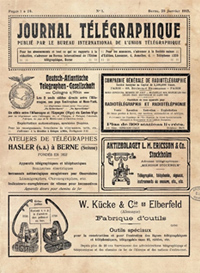About the collection
1870-1900
Over the next three decades, the Journal published news about the condition of telegraph and telephone networks – including new lines - tariffs and national regulations. Other material included statistics, bibliographies, and articles on technological advances. A series of special articles on the situation of telegraphy and telephone in various countries appeared in the 1890s. The Journal also marked the passing of great figures in electrical science, telegraph and telephone development. For example, lengthy obituaries noted the deaths of Samuel Morse in 1872 (American inventor and co-developer of the Morse code), Charles Wheatstone in 1875 (English physicist and prolific inventor who had launched the world’s first practical telegraph service in in London in 1839), Dr. Werner von Siemens in 1892 (founder of the German electrical and telecommunications company Siemens), and Emile Baudot in 1903 (French telegraph engineer and inventor of the Baudot code). The Journal proved to be very popular, and by 1900 had more than doubled the original number of subscribers, announcing a circulation of 1750 subscriptions.

A page of advertising in the January 1915 issue |
Advertising The Journal has alternated periods of advertising with periods of no advertising. Names and addresses of manufacturers and suppliers first appeared in 1870 when the Director of the ITU Bureau asked Administrations to send the names of businesses who, on the basis of experience, could be particularly recommended for their excellent products or moderate prices. Starting in January 1915, 4 pages of advertising were included as a “cover” to each issue of the Journal. In the 1930s, the acceptance of commercial advertising was seen as a startling innovation by some other international organizations, but was regarded as a “valuable source of information” by other readers. |
18691900-1934



